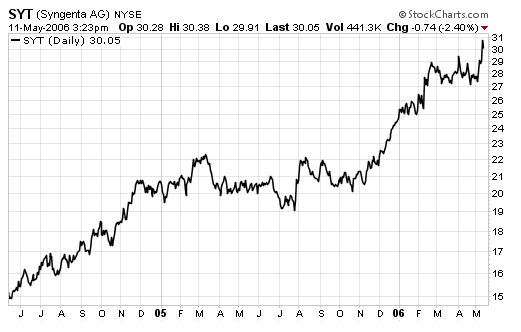| Home | About Us | Resources | Archive | Free Reports | Market Window |
The Past and Future of EnergyBy
Friday, May 12, 2006
Steve Sjuggerud’s note: Contributing today’s essay is my friend and colleague Dan Denning. For making sense of what’s going on around the world – and profiting from it – Dan is among the best analysts in the world.
There is one benefit to high oil prices… and that’s massive innovation that will bring about new forms of fuel. In this time of upheaval, some companies will make an absolute fortune. We’ve seen the transition time and again, as resources get scarce. When whale oil finally became scarce, the English switched to wood. After deforesting the country, the English switched to coal. Coal made the modern world, kicking off the Industrial Revolution. And then came oil… Oil has been cheap enough, for long enough, that we haven’t needed to switch. Now it’s expensive again, and it's time to look for alternatives in energy. Let’s take a deeper look… Wood was the first best source of energy (heat) for fire-taming men because it was lying around. You could pick it up or cut it down. This is exactly what people did in pre-Industrial Revolution Britain. As the population grew, the forests shrank. Timber was needed for building and heating, and it was often in the way of farmland needed to feed the growing populations of large cities. Water could power mills. And peat could be used for heat. But neither were abundant enough to power a growing nation. Timber, unlike coal and oil, is renewable. But you have to be a good steward, keeping an eye on the future, to avoid merely consuming your resources in pursuit of growth. The British were busy growing. There was no time for stewardship of the forests. But geologically speaking, Britain was fortunate. When the trees were gone, there was still something left. It was a black rock, lying around on the ground. It was rock that burned. Coal gave heat and lasted longer than wood. It was the perfect replacement. It was cheap. It was abundant. And it provided both heat and light for hundreds of thousands of Britons. Eventually, as coal demand in Britain grew, mines had to be dug deeper. This same industrial dynamic played out in America, but with two slight differences. Oil was even cheaper and more abundant than coal, and could be used for a liquid fuel. Once the automobile and the internal combustion engine got together...then the vast distances of the country could be traversed by car, rather than rail, and later by air. Today, the situation is a lot different… Cheap fuel is no longer a reality. A whole century of fossil fuel consumption is behind us. A whole economy sprung up around the use of a cheap fuel is not sustainable if fossil fuels become more scarce. So where do we go from here? There’s enough coal in the United States to last for another 250 years (much of it is in Western states like Idaho, Colorado, Utah, Montana, and Wyoming). And even though half of the nation’s energy is already generated by coal-fired power plants, another 130 plants are in the development stages. For what it’s worth, both China and India have made coal gasification and liquefaction projects high priorities in their respective national energy strategies. When George Bush signed a deal with India to help that country develop the energy its economy needs to grow, it was front-page news. What didn’t make the news was that a Coal Working Group formed between the two counties is working on sharing information for exploiting coal-bed methane, coal gasification and liquefaction, and other clean coal-related technologies. China’s government is hard at work with research institutions to develop proprietary technology for coal liquefaction and gasification. China would also like — and desperately needs — to cut coal emissions. It has, in fact, made a zero-emissions coal-fired power plant one of its goals. Whether China, or any country for that matter, can finally clean up coal is open to debate. What I like about the whole debate, though, is that it’s one of the few industries I see out there in which technology actually can lead to cleaner, more efficient use of abundant hydrocarbons. Readers of my investment letter Strategic Investment know that I write about forms of energy and scarce resources. I’ve written a lot about water lately. But when I look at coal, I see a resource we can make cleaner and more efficient, that’s abundant and will last hundreds of years. Instead of buying up oil companies, I recommend you look at companies with exposure to coal instead. You never hear about this, but I think it is the direction we’re headed. Good investing, Dan Denning, Market NotesTHE BULL MARKET IN GM FOODS RESUMES Although the scarcity of natural resources like oil, coal, and copper grabs all the headlines, there’s another resource market hitting new highs… the bull market in genetically modified (GM) foods. As the emerging markets of the world grow larger and richer, they’ll need an enormous amount of food. The high crop yields of GM seeds will help produce it. Another breakout… Swiss-based GM food giant Syngenta (2-yr chart):
-Brian Hunt |
Recent Articles
|


